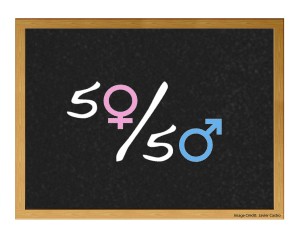The journal Intelligence recently published an interesting study [1] analyzing gender differences in cognitive abilities in the US and India.
The question hovering in the background is—as it so often is—“are there innate gender differences in cognitive abilities?”
That is: we have lots of data showing gender differences in various measures of academic success; are those differences inherent in genders, or are they socially created? Or, a combination of both?
To answer this question, you might look at the very best performers in—say—math. If there are substantially more boys in the top 5% of math scorers, and if that substantial difference persists over time, then you might think that–all other things being equal–boys are innately better at math.
This study, however, shows that the difference has shrunk in the last twenty years—in both the US and India. If gender differences in math are innate, then these results are a shocker.
Of course, other readers might see this study reinforcing a theory of innate gender differences.
- Although there is a smaller difference in math success between genders, that difference does persist. That is: there are still more boys than girls at the very highest end of math performance.
- The gender difference at the high end of verbal performance has not changed. Girls still score higher than boys do on such tests.
In my view, this study tends to confirm the hypothesis that social forces exaggerate—and perhaps create—gender differences in academic performance.
- I suspect that gender differences in verbal performance haven’t changed because we haven’t focused on them with the same energy and creativity that we’ve used to promote girls’ self-perception in math.
- While math gender differences persist in the US and India, they vary quite widely by country [2]: an odd finding indeed if boys are naturally mathier than girls.
Reasons to be cautious when interpreting this article—and this blog post:
- This research looks at gender differences in one very specific way: math and verbal performance at the very high end (“the extreme right tail” of the bell curve). There are MANY other ways to consider these complex questions, and we shouldn’t let any one way determine our answer.
- We have only recently begun to understand that gender isn’t always binary. I don’t think many researchers in this field have found ways to analyze math performance of transgender students.
- The article is still behind a paywall, so I haven’t seen the numbers. You might want to look at the underlying data to see if you find it persuasive.
- I, of course, have my own biases:
- I think that gender differences in academic performance are much more likely to be socially created than innate [3, 4]. And so, it’s not surprising that I interpret this article as I have. (It’s also not surprising that I’ve decided to write about it for the blog.)
- More broadly, I think the “innate differences” hypothesis just isn’t helpful to teachers. My job is to help this student learn academic material—these facts, these procedures, these moral habits, these life lessons. If I clutter my brain with the belief that “girls can’t do math,” I do my students a deep disservice because I make it harder for them to learn. That is: my potentially false belief turns into a self-fulfilling prophecy. All of Carol Dweck’s research [5, 6] and all Claude Steele’s research [7, 8], highlights this point.
If you’re especially interested in this topic, Lisa Damour—Director of Laurel School’s invaluable Center For Research on Girls—has produced many evidence-based summaries that can be helpful to your thinking.
- Makel, M. C., Wai, J., Peairs, K., & Putallaz, M. (2016). Sex differences in the right tail of cognitive abilities: An update and cross cultural extension. Intelligence, 59, 8-15.
- Else-Quest, N. M., Hyde, J. S., & Linn, M. C. (2010). Cross-national patterns of gender differences in mathematics: a meta-analysis. Psychological Bulletin, 136(1), 103.
- Hyde, J. S. (2005). The gender similarities hypothesis. American Psychologist, 60(6), 581.
- Eliot, L. (2009). Pink brain, blue brain: How small differences grow into troublesome gaps – and what we can do about it. Boston: Houghton Mifflin Harcourt.
- Dweck, C. (2008). Mindset: The new psychology of success. New York: Ballantine Books.
- Rattan, A., Good, C., & Dweck, C. S. (2012). “It’s ok—Not everyone can be good at math”: Instructors with an entity theory comfort (and demotivate) students. Journal of Experimental Social Psychology, 48(3), 731-737.
- Steele, C. (2010). Whistling Vivaldi: How stereotypes affect us and what we can do. New York: W. W. Norton & Company.
- Murphy, M. C., Steele, C. M., & Gross, J. J. (2007). Signaling threat how situational cues affect women in math, science, and engineering settings. Psychological Science, 18(10), 879-885.


